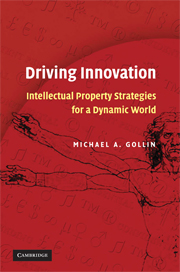Book contents
- Frontmatter
- Contents
- Foreword
- Preface
- Acknowledgments
- Abbreviations
- Introduction: The Invisible Infrastructure of Innovation
- PART I INTELLECTUAL PROPERTY DYNAMICS IN SOCIETY
- 1 Intellectual Property and the Innovation Cycle
- 2 The Rise of the Intellectual Property System
- 3 Keeping the System in Balance: Exclusion and Access
- PART II BASICS OF MANAGING INTELLECTUAL PROPERTY IN ORGANIZATIONS
- PART III STEPS TO STRATEGIC MANAGEMENT OF INTELLECTUAL PROPERTY
- PART IV STRATEGIES ON A GLOBAL STAGE
- APPENDIX A Excerpts from TRIPS Agreement
- APPENDIX B Intellectual Property Non-Policy
- APPENDIX C Intellectual Property Assessment Questionnaire
- APPENDIX D Research Tools for Obtaining Intellectual Property Information
- Bibliography
- Index
2 - The Rise of the Intellectual Property System
Published online by Cambridge University Press: 05 June 2012
- Frontmatter
- Contents
- Foreword
- Preface
- Acknowledgments
- Abbreviations
- Introduction: The Invisible Infrastructure of Innovation
- PART I INTELLECTUAL PROPERTY DYNAMICS IN SOCIETY
- 1 Intellectual Property and the Innovation Cycle
- 2 The Rise of the Intellectual Property System
- 3 Keeping the System in Balance: Exclusion and Access
- PART II BASICS OF MANAGING INTELLECTUAL PROPERTY IN ORGANIZATIONS
- PART III STEPS TO STRATEGIC MANAGEMENT OF INTELLECTUAL PROPERTY
- PART IV STRATEGIES ON A GLOBAL STAGE
- APPENDIX A Excerpts from TRIPS Agreement
- APPENDIX B Intellectual Property Non-Policy
- APPENDIX C Intellectual Property Assessment Questionnaire
- APPENDIX D Research Tools for Obtaining Intellectual Property Information
- Bibliography
- Index
Summary
This chapter begins by detailing the various definitions people use for intellectual property – from dictionaries, law, accounting, management, and scholars. The chapter continues by chronicling the rise of the global intellectual property system, from its roots in ancient times, through the Venetian innovation of patent law. The chapter finishes with a summary of the evolution of the modern international framework of intellectual property laws.
DEFINING INTELLECTUAL PROPERTY
Before going further, we should clarify the definitions of intellectual property. People use the term “intellectual property” to refer to at least five different concepts, and this causes great confusion. By being aware of each definition, an informed reader can identify which meaning is intended in a given context. This is an important step toward intellectual property literacy in the global arena. Even people experienced with specific aspects of intellectual property may not be familiar with all the definitions. Being able to discriminate between them is a starting point for understanding the many conflicting views of the topic.
Dictionaries. Dictionaries define intellectual property essentially as something intangible, created by the use of mental ability, to which legal rights attach. The bundle of legal rights generally associated with ownership of property since Roman times includes the right to use a piece of property, to exclude others, and to benefit from, transfer, or destroy the property.
- Type
- Chapter
- Information
- Driving InnovationIntellectual Property Strategies for a Dynamic World, pp. 22 - 35Publisher: Cambridge University PressPrint publication year: 2008



